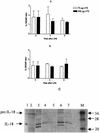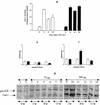Role of caspase 1 in murine antibacterial host defenses and lethal endotoxemia
- PMID: 12438367
- PMCID: PMC133093
- DOI: 10.1128/IAI.70.12.6896-6903.2002
Role of caspase 1 in murine antibacterial host defenses and lethal endotoxemia
Abstract
Sepsis is thought to result from an exaggerated innate immune response to microbial components such as lipopolysaccharide (LPS), but the involvement of a specific mechanism(s) has not been identified. We studied the role of caspase 1 (Cas-1) in the murine innate immune response to infection with gram-negative bacteria and to nonlethal and lethal doses of LPS. cas-1(-/-) and Cas-1 inhibitor (Ac-YVAD-CHO)-treated cas-1(+/+) mice were two- to threefold more susceptible to lethal Escherichia coli infection than cas-1(+/+) mice. Administration of Cas-1 products, interleukin-18 (IL-18) or IL-1beta, protected three of three and six of seven mice, respectively, from lethal infection with E. coli compared to none of six of untreated mice (P = 0.0082). Therefore, cas-1 is essential for antibacterial host defense. Nonlethal (75 micro g) and lethal (500 micro g) doses of LPS induce different patterns of gamma interferon, IL-1beta, and IL-18 expression. Consequently, the role of Cas-1, which cleaves pro-IL-18 and pro-IL-1beta to their active forms, was investigated in these disparate conditions by using enzymatic assay and reverse transcription-PCR. At 75 micro g, LPS induced a transient increase in IL-1beta and IL-18 levels in serum, whereas at 500 micro g it induced a 1.5-fold-higher IL-18 level in serum, which increased till death. At 75 micro g of LPS, splenic cas-1 mRNA expression remained unchanged at all time points, but activity increased transiently at 3 h. In lethally treated mice, Cas-1 activity remained elevated until death; however, cas-1 mRNA levels increased at 3 h and decreased to basal levels by 8 h. Treatment with Cas-1 inhibitor protected mice from lethal endotoxemia. Thus, Cas-1 is essential for innate antibacterial host defenses and may represent a mechanism of innate immunity that upon excessive stimulation by microbial components may lead to endotoxic shock.
Figures





References
-
- Akita, K., T. Ohtsuki, Y. Nukada, T. Tanimoto, M. Namba, T. Okura, R. Takakura-Yamamoto, K. Torigoe, Y. Gu, M. S. Su, M. Fujii, M. Satoh-Itoh, K. Yamamoto, K. Kohno, M. Ikeda, and M. Kurimoto. 1997. Involvement of caspase-1 and caspase-3 in the production and processing of mature human interleukin 18 in monocytic THP.1 cells. J. Biol. Chem. 272:26595-26603. - PubMed
-
- Bohn, E., and I. B. Autenrieth. 1996. IL-12 is essential for resistance against Yersinia enterocolitica by triggering IFN-γ production in NK cells and CD4+ T cells. J. Immunol. 156:1458-1468. - PubMed
-
- Bohn, E., A. Sing, R. Zumbihl, C. Bielfeldt, H. Okamura, M. Kurimoto, J. Heesemann, and I. B. Autenrieth. 1998. IL-18 (IFN-γ-inducing factor) regulates early cytokine production in, and promotes resolution of, bacterial infection in mice. J. Immunol. 160:299-307. - PubMed
Publication types
MeSH terms
Substances
Grants and funding
LinkOut - more resources
Full Text Sources
Other Literature Sources
Miscellaneous

